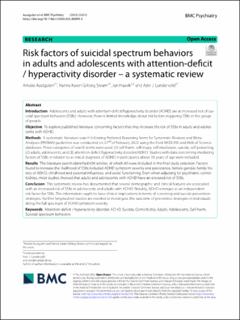| dc.contributor.author | Austgulen, Amalie | |
| dc.contributor.author | Skram, Nanna Karen Gilberg | |
| dc.contributor.author | Haavik, Jan | |
| dc.contributor.author | Lundervold, Astri J. | |
| dc.date.accessioned | 2023-09-14T07:27:54Z | |
| dc.date.available | 2023-09-14T07:27:54Z | |
| dc.date.created | 2023-09-09T19:09:54Z | |
| dc.date.issued | 2023-08-21 | |
| dc.identifier.issn | 1471-244X | |
| dc.identifier.uri | https://hdl.handle.net/11250/3089334 | |
| dc.description.abstract | Introduction: Adolescents and adults with attention-deficit/hyperactivity disorder (ADHD) are at increased risk of suicidal spectrum behaviors (SSBs). However, there is limited knowledge about risk factors triggering SSBs in this group of people.
Objective: To explore published literature concerning factors that may increase the risk of SSBs in adults and adolescents with ADHD.
Methods: A systematic literature search following Preferred Reporting Items for Systematic Reviews and Meta-Analyses (PRISMA) guidelines was conducted on 22nd of February 2022 using the Ovid MEDLINE and Web of Science databases. Three categories of search terms were used: (1) self-harm, self-injury, self-mutilation, suicide, self-poisoning; (2) adults, adolescents; and (3) attention-deficit hyperactivity disorder/ADHD. Studies with data concerning mediating factors of SSBs in relation to a clinical diagnosis of ADHD in participants above 16 years of age were included.
Results: The literature search identified 604 articles, of which 40 were included in the final study selection. Factors found to increase the likelihood of SSBs included ADHD symptom severity and persistence, female gender, family history of ADHD, childhood and parental influences, and social functioning. Even when adjusting for psychiatric comorbidities, most studies showed that adults and adolescents with ADHD have an elevated risk of SSBs.
Conclusion: This systematic review has documented that several demographic and clinical features are associated with an increased risk of SSBs in adolescents and adults with ADHD. Notably, ADHD emerges as an independent risk factor for SSBs. This information ought to have clinical implications in terms of screening and suicide prevention strategies. Further longitudinal studies are needed to investigate the outcome of preventive strategies in individuals along the full spectrum of ADHD symptom severity. | en_US |
| dc.language.iso | eng | en_US |
| dc.publisher | BMC | en_US |
| dc.rights | Navngivelse 4.0 Internasjonal | * |
| dc.rights.uri | http://creativecommons.org/licenses/by/4.0/deed.no | * |
| dc.title | Risk factors of suicidal spectrum behaviors in adults and adolescents with attention-deficit / hyperactivity disorder – a systematic review | en_US |
| dc.type | Journal article | en_US |
| dc.type | Peer reviewed | en_US |
| dc.description.version | publishedVersion | en_US |
| dc.rights.holder | Copyright 2023 the authors | en_US |
| dc.source.articlenumber | 612 | en_US |
| cristin.ispublished | true | |
| cristin.fulltext | original | |
| cristin.qualitycode | 2 | |
| dc.identifier.doi | 10.1186/s12888-023-05099-8 | |
| dc.identifier.cristin | 2173715 | |
| dc.source.journal | BMC Psychiatry | en_US |
| dc.identifier.citation | BMC Psychiatry. 2023, 23, 612. | en_US |
| dc.source.volume | 23 | en_US |

